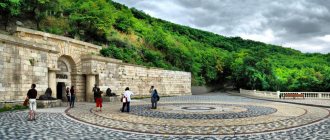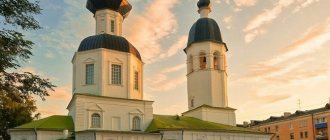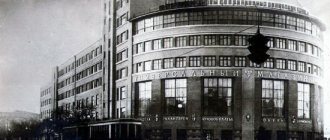Usually, those who have never been to Kaliningrad have at least a couple of myths about this city living in their heads. Well, for example, that you can’t get here without a foreign passport (you can), and Kaliningrad residents themselves can travel to Europe without visas (oh, if only).
Or the fact that Kaliningrad women dress in old German clothes for the holidays (what?).
So, before planning a trip to Kaliningrad, you should first figure out where it is and what this city is like.
Basic information
Story
It was founded on September 1, 1255. The beginning of the modern city was a castle erected on the site of the Prussian fortification of Twangste in the lower reaches of the Pregel River.
The founders are considered to be the Grand Master of the Teutonic Order Poppo von Osterna and the King of the Czech Republic Přemysl Otakar II. Tvangste was besieged by knights, but after help arrived from the king of the Czech Republic, the settlement fell. The first structure was made of wood, and in 1257 the construction of brick walls began.
The castle was named Königsberg ; it was besieged by Prussian tribes three times (in 1260, 1263 and 1273), but survived. In subsequent years, German colonists began to arrive to develop Prussian lands. The indigenous people were assimilated and by the 16th century only 20% of the total population remained.
You may also be interested in: “Koenigsberg City Gate: history, photo and description”
On February 28, 1286, the settlement near the castle walls, bearing the same name, was awarded city rights. Other settlements were rapidly growing around. In 1300, another city began to be called Löbenicht, where the first printing house was opened in 1523, and the first book was printed in 1524.
From an administrative point of view, both cities were independent, but in fact they formed a single whole . The united cities were named Königsberg, and the first and oldest part of it was renamed Altstadt (“old city”).
The third settlement to receive official status was Kneiphof and it also formed part of Königsberg.
In 1466, as a result of the Thirteen Years' War, the capital of the Teutonic Order was moved from Marienburg to Königsberg.
In 1525, the theocratic state became known as the Duchy of Prussia, and Grand Master Albrecht proclaimed himself duke. Since the 16th century, the city became a cultural center, important figures lived there and the first books were published in the Lithuanian language.
In 1660, the publication of its own newspaper began , its copies were regularly sent to Russia to compile reviews intended for the Boyar Duma and Tsar Alexei Mikhailovich.
Territorially unified, but consisting of administratively independent districts, the city existed until 1724, then the official unification of the three cities, their surrounding suburbs, villages and the castle took place. The name remains the same - Koenigsberg.
During the Seven Years' War, the city was captured by Russia and from 1758 to 1762 was part of it. In 1762 it was returned to Prussia under the terms of the St. Petersburg Peace Treaty concluded with it by the Russian Emperor Peter III.
In the 19th century, Königsberg grew and modernized rapidly, with countless ravelins, bastions and defensive ramparts built (many of the buildings still exist).
In 1857, a railway appeared in Königsberg , and in 1862 a railway connection with Russia was established. In May 1881, a new type of transport appeared - horse-drawn (horse-drawn - city railway), and exactly 14 years later (in 1895) - the first trams. In 1901, the electrification of public transport began.
In 1919, the first airport in Germany and one of the first in the world, Devau, was built and put into operation. Regular flights Konigsberg - Riga - Moscow were organized in 1922. In the 20th century, the city expanded significantly; the following were built:
- train stations;
- residential buildings;
- commercial buildings.
The greatest contributions to the architecture of the city were made by Hans Hopp and Friedrich Heitmann. A large place was devoted to monuments and sculptures; they were created by both graduates and teachers of the Koenigsberg Academy of Arts. At the same time, research and reconstruction were carried out in the old castle.
In August 1944, during the British bombing, the city was heavily damaged and the entire old center of Königsberg was destroyed.
That same year, it was stormed by Soviet soldiers.
Assault and capture in 1945
The siege of the city began in December 1944, and assault troops were sent on April 5, 1945. On April 10, a flag was raised over the Der Dona Tower (the modern Amber Museum), marking the end of German rule. During fierce battles, both sides suffered losses of 50 thousand people .
We invite you to watch a video about the assault on Koenigsberg.
Who was given a medal for taking it?
On June 9, 1945, the Presidium of the USSR Armed Forces ordered the establishment of a medal for the capture of the fortress city of Koenigsberg.
This medal was awarded to military personnel of the army, navy and NKVD troops who took personal part in the battle for the city, as well as the organizers and leaders of military operations in the period from January 23 to April 10, 1945.
This medal is the only one established in the USSR for the capture of a fortress; all the others were for the liberation and capture of capitals.
The Legend of Underground Kaliningrad
The essence of the legend is that under the city there is an underground city - a backup city, built during German rule . It has power plants, numerous warehouses for food and household goods, and tank and aircraft factories.
Also, the underground city is a repository for many valuables, including the Amber Room. There are two versions of the ending of the legend:
- During the assault on the city by Soviet soldiers, the Germans collapsed and partially flooded several passages.
- After the war, an expedition was sent to the dungeon, but it was not able to fully explore all the passages. It was decided to wall up the unexplored tunnels.
Some residents claim that all systems in the lower city are working properly and sometimes someone turns them on to check, then a rumble is heard from the basements and a glow appears.
According to some versions, people still live underground.
The legend originated back in the 1950s; its appearance was provoked by numerous artistic and documentary works of those times.
Where is it located on the map?
The city is located on the shores of the Baltic Sea . On the southern side it borders with Poland, and on the eastern and northern side – with Lithuania. It has no land borders with Russia.
What does this name mean in German?
- The center of the city was the castle, which at its foundation was called “Royal Mountain” (translated from German Königsberg), in honor of the Czech King Přemysl Otakar II, one of the founders.
- According to another version, the word “Königsberg” is of Gothic origin: kuniggs is the head of the clan, and berg is the shore.
Which country does it belong to?
In 1945, the Potsdam Conference was held, by its decision the German province, along with its capital, was annexed to the Soviet Union. After the death of the chairman of the Supreme Council M.I. Kalinin on July 4, 1946, the city received a new name - Kaliningrad , and its region became Kaliningrad.
Coat of arms
The modern coat of arms was approved on July 17, 1996 and finalized on April 28, 1999. The authors of the project are Ernest Grigo and Sergei Kolevatov.
The ancient coat of arms of Königsberg was taken as a basis. On a blue background there is a silver ship with one sail and a silver two-pointed pennant with the St. Andrew's Cross. The mast goes down with three green leaves. Under the ship are 12 gold bezants arranged in a wave shape.
In the center of the mast there is a shield crossed with silver and scarlet, in the upper part there is a crown, in the lower part there is an equal-ended Greek cross (both figures of variable colors). Around the shield is a ribbon of the medal for the capture of Königsberg .
Ethnic composition
The national composition of the population of Kaliningrad was formed within the framework of the state migration policy of the Soviet government. Skilled workers from Central Russia, Belarus and Ukraine were best suited to fill industrial jobs. Residents of the Baltic republics did not meet the necessary criteria. And not because they did not inspire confidence in the government to settle in the border area.
The main reason that there are practically no Baltic nationalities in the national composition of the population of Kaliningrad is the lack of a sufficient number of specialists in the Baltic republics in the 40s and 50s to work on industrial equipment. At the factories of Riga and Klaipeda, this was done by the Germans who lived there, who also left for Germany for the same reasons as the Germans of Konigsberg - Kaliningrad.
It is quite natural that the national composition of the residents of the Kaliningrad region as an industrial region today has formed in the following form:
| Nationality | Number (persons) | % of total |
| Russians | 786 885 | 82,37% |
| Belarusians | 50 748 | 5,31% |
| Ukrainians | 47 229 | 4,94% |
| Lithuanians | 13937 | 1,46% |
| Persons who did not indicate nationality | 8859 | 0,93% |
The number of other nationalities represented in Kaliningrad indicates their appearance in this region outside the main migration trend, but also without contradictions with the usual national migration processes in the Soviet and post-Soviet space associated with new economic phenomena: Armenians (0.88%), Germans (0.87%), Tatars (0.50%), Poles (0.41%), Azerbaijanis (0.31%).
Also 1 - 2 tenths of a percent are represented by Mordovians, Chuvashs, Jews, Gypsies, and Moldovans. Less than 1 tenth of a percent of the population of Kaliningrad are Chechens, Latvians, Georgians, Koreans, Uzbeks, Kazakhs, Bashkirs, Yezidis, Mari.
the Royal Castle
Story
Founded in 1255 on former Prussian territory. Initially, the structure was defensive in nature and was built of wood; later it was reinforced with stone walls. In the early period, the appearance of the castle was dominated by the Gothic style, but over time the purpose of the building itself changed and its architectural appearance changed.
With the coming to power of Duke Albrecht in 1525, the castle turned into a secular palace . Coronations and receptions were held in its halls. In the 18th century, in the basement of the northern wing there was a wine restaurant “Blütgericht”, translated as “Bloody Judgment”. Previously, the restaurant premises were a prison, and there was a trial over it.
At the beginning of the 20th century, the castle served as a museum; rare collections were located within its walls:
- books;
- paintings;
- weapons.
The castle was captured by the Germans during the Second World War , where meetings were held and valuables from plundered countries were stored. One of these loots was the famous Amber Room, transported by the Germans from Pushkin. Its current location is unknown.
The castle was heavily damaged during the war, but the final “collapse” occurred in 1968 - by order of the Soviet authorities, the building was blown up, and the remaining stones were used for new buildings. Several attempts were made to begin the restoration of the castle. Excavations on its territory are periodically resumed, the last ones dating back to 2016.
Where can you find ruins?
The ruins of the castle are located at: st. Shevchenko 2 , public transport stop "Hotel Kaliningrad". Landmark – House of Soviets, built on the territory of a former castle. The visit is paid and possible any day from 10 to 18.
Data by year
Statistics show a steady rise after 2011:
| Number of inhabitants | Year |
| 433 532 | 2012 |
| 441 376 | 2013 |
| 448 548 | 2014 |
| 453 461 | 2015 |
| 459 560 | 2016 |
| 467 289 | 2017 |
| 475 056 | 2018 |
| 482 443 | 2019 |
At the beginning of 2022, 489,359 people lived in Kaliningrad.
What other attractions are there?
- Fishing village . An ethnographic, craft and shopping complex on the banks of the Pregel River, stylized as old Prussia. It was built in 2006.
- Kant Island (Kneiphof). Located in the middle of the Pregel River, in the 14th century there was an entire city with its own coat of arms. In 1944, the island had 28 streets, 304 houses, public transport ran, and during the bombing in August of the same year, the city was completely destroyed. Now the only building is the Cathedral, surrounded by alleys and sculptures.
- Museum of the World Ocean . Opened in 1990 with the aim of preserving and popularizing Russia's maritime heritage. The museum presents the history of shipbuilding and exhibitions dedicated to marine flora and fauna, as well as the study of the seabed.
- Holy Cross Cathedral . Located on Oktyabrsky Island. Until 1945, there was a Lutheran-Evangelical shrine here, bearing the name of the Church of the Cross. Currently it is an Orthodox church. The central element in the external decoration is a mosaic Protestant cross on the facade, framed by an ornament with lilies and wind roses. The inside of the church is decorated in accordance with Orthodox traditions.
Natural movement
The birth rate, the main indicator of vital statistics, which the government is fighting to improve, has been showing some positive dynamics for more than ten years: from 11.3 births per 1 thousand people. in 2008 to 13.2 in 2022. At the same time, the number of deaths per 1 thousand people. decreased from 14.4 in 2008 to 12.1 in 2018. And yet, in 2022, 2,634 more people died in the Kaliningrad region than were born.
Forts
Beginning in the 19th century, instead of a continuous wall, a network of forts (earthen fortifications with stone buildings that could accommodate 300 soldiers and a supply of ammunition) was built around the city. The territory between them was shelled by artillery, and at a later time by machine guns.
The defensive ring around Koenigsberg consisted of 12 large and 5 small forts and was called the “night feather bed”.
This defense system was tested in April 1945, coming under fire from the Soviet Army.
Most of the forts were destroyed, and the few that remained were abandoned until recently. Monuments of fortification art are gradually being restored. Two forts are available in excursion mode:
- No. 5 King Frederick William III;
- No. 11 Dönhoff.
Below is a video about the forts of Koenegsberg.
Migration
For 20 years, the city has been one of the six main centers of internal migration activity among the regions of the Russian Federation. This factor provides a positive balance in the demography of Kaliningrad and the region: by January 1, 2022, the population over the previous 3 years grew by 2.7% (to 1012.5 thousand people). The natural decline (minus 6 thousand) was more than covered by the migration increase of 32.1 thousand people.
Photo
In the photo below you can see the main historical attractions of the city:
Physiographic indicators
It is no coincidence that many years ago the population of Kaliningrad began to grow rapidly. People were attracted by the proximity to the Pregolya River. Now the city is located on both its banks. There are many water bodies here that can improve the state of the environment. These are various ponds, streams and lakes.
The locality lives according to Kaliningrad time. The offset relative to Moscow is two hours ahead. The city's climate changes from maritime to continental. Winters here are much warmer than in the Russian capital. Sometimes you have to wait several months for snow. But in the summer it is quite hot here. It is no coincidence that there are many health resorts near the city.
When and how did the deportation of Germans take place?
In 1946, Stalin signed a decree on the voluntary resettlement of 12 thousand Russian families from 27 different regions to Kaliningrad. From 1945 to 1948, several dozen Germans coexisted with Russians in the city, German schools, churches and public organizations operated.
But this neighborhood cannot be called peaceful - the Germans were regularly subjected to violence and looting by the Soviet population. The government tried in every possible way to eliminate hostility between peoples:
- a newspaper was published;
- training was conducted in German;
- Working Germans were given food cards.
Due to the impossibility of peaceful coexistence and increasing incidents of violence, in 1947 a decision was made to forcibly deport the German population.
Between 1947 and 1948, about 100 thousand German citizens and Prussian Lithuanians were resettled.
The deportation took place peacefully and in an orderly manner; former residents of East Prussia were allowed to transport any amount of cargo with them, they were also given dry rations and conscientious assistance was provided during the movement.
Receipts were taken from all those leaving that they had no claims against the Soviet Government . Some German specialists were left to restore agriculture and production, but they also did not receive citizenship and eventually left the country.
The history of Koenigsberg as the Russian city of Kaliningrad is just beginning. Its cultural image has undergone significant changes over the past 15 years:
- new museums appeared;
- forts were restored;
- The first Orthodox church was built.
For a long time, the architectural heritage of the Prussian lands fell into decay, but modern society set about restoring them.
Kaliningrad airport
Khrabrovo International Airport is located in Kaliningrad. The distance from the airport to the city center is 20 km. The airport has the status of a federal facility and is a joint airfield - in addition to civil aircraft, there is military aviation. The airport's operating hours are 24 hours a day.
Popular destinations of regular and charter flights: Moscow, St. Petersburg, Minsk, Kazan, Kaluga, Nizhny Novgorod, Tashkent, Sochi, Gomel, Voronezh, Lipetsk, Yekaterinburg, Warsaw, Brest, Cherepovets, Belgorod. The airport serves major Russian and international airlines: S7 Airlines, Russia, Ural Airlines, Aeroflot, LOT, Uzbekistan Airways, Onur Air, NordStar, airBaltic. The annual passenger traffic is more than 1.7 million people, the annual cargo traffic is more than 6.5 million tons.
City museums
The Kaliningrad Population Support Center pays special attention to the cultural development of city residents. Museums are supported by the local administration. Funds from the federal budget are also allocated for their development. A lot of good reviews can be heard about the Kaliningrad Art Gallery, which was opened in November 1988. The museum is famous not only in the country, but also abroad. The works of world-famous artists are exhibited here. There are also works by local artists.
The Amber Museum, which opened to visitors in December 1979, may also be of interest to visitors. Here are various jewelry and paintings created from minerals.
Education
The population of Kaliningrad is rapidly increasing due to the presence of a large number of higher educational institutions in the city. Many applicants come here for admission and stay in the locality for many years, building families. The most popular is the Kaliningrad Law Institute of the Ministry of Internal Affairs of Russia, which was founded in 1953. At the same time, the Kaliningrad Police School was created. The educational process here is organized in full-time and correspondence forms.
A lot of good reviews can also be heard about the Kaliningrad State Technical University, which began its work back in 1930. Here children can get an education in many engineering specialties. Graduates get the opportunity to work in the country's leading factories.
In Kaliningrad, attention is paid to the physical and creative development of the younger generation. There are music schools, centers for children and youth creativity, and numerous sports sections.











